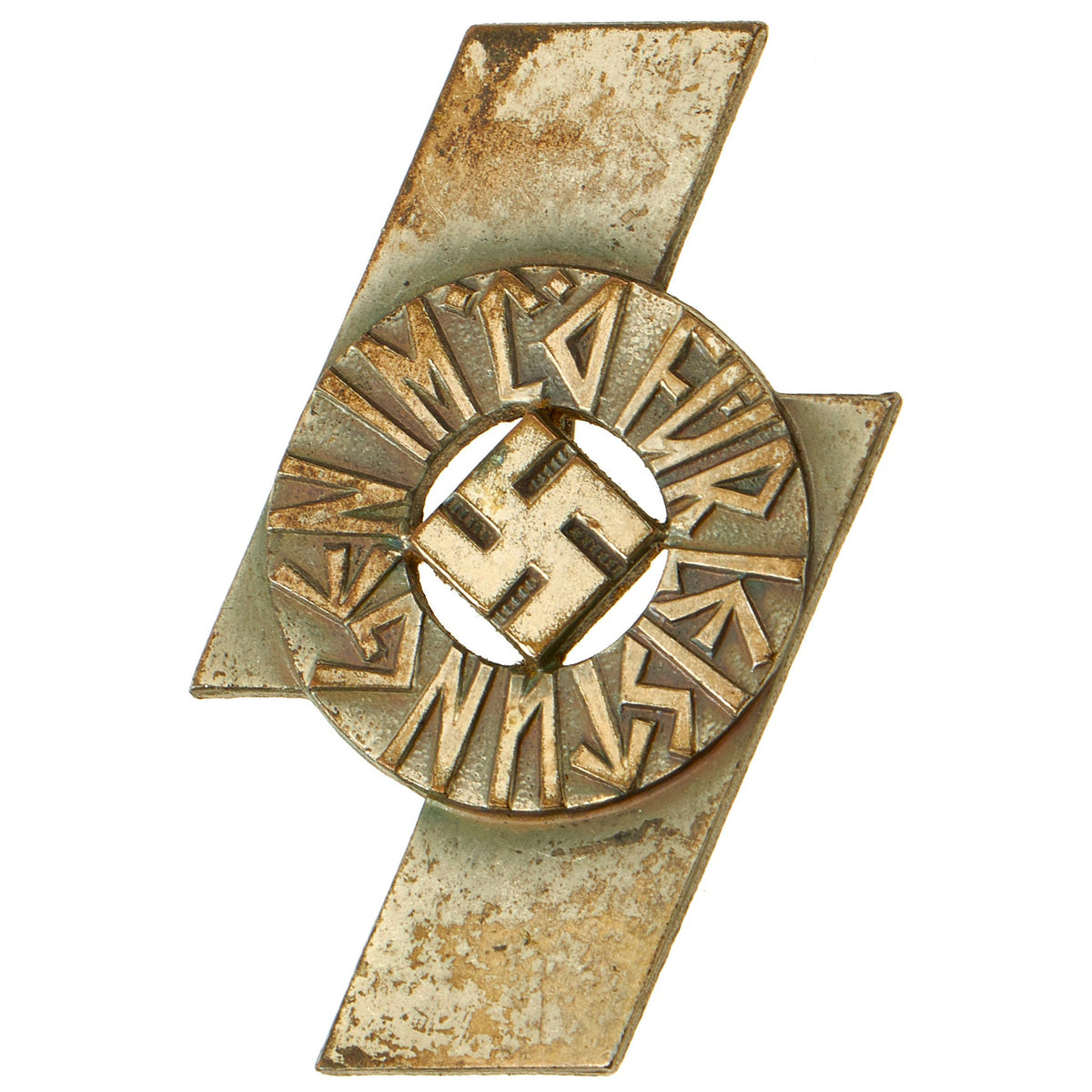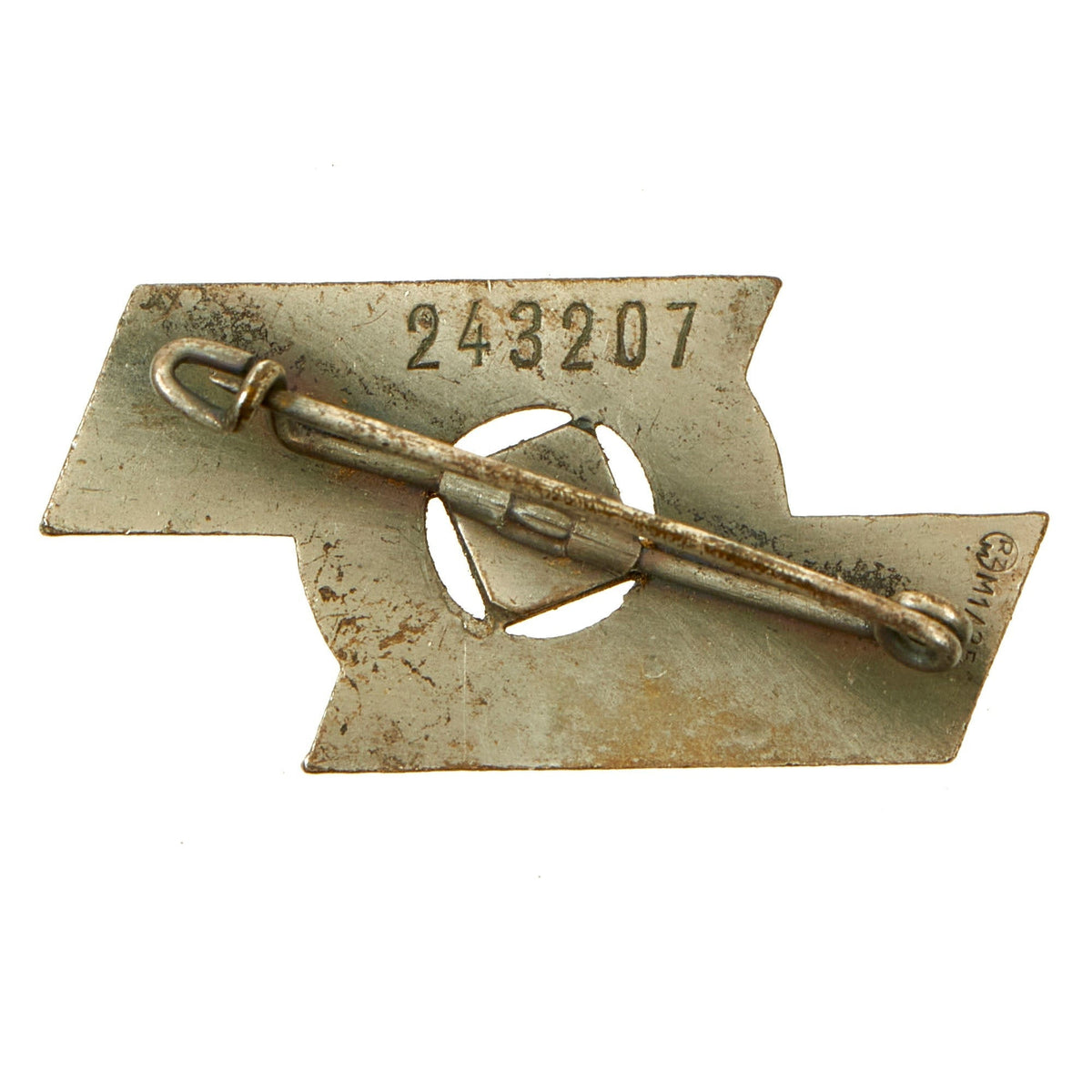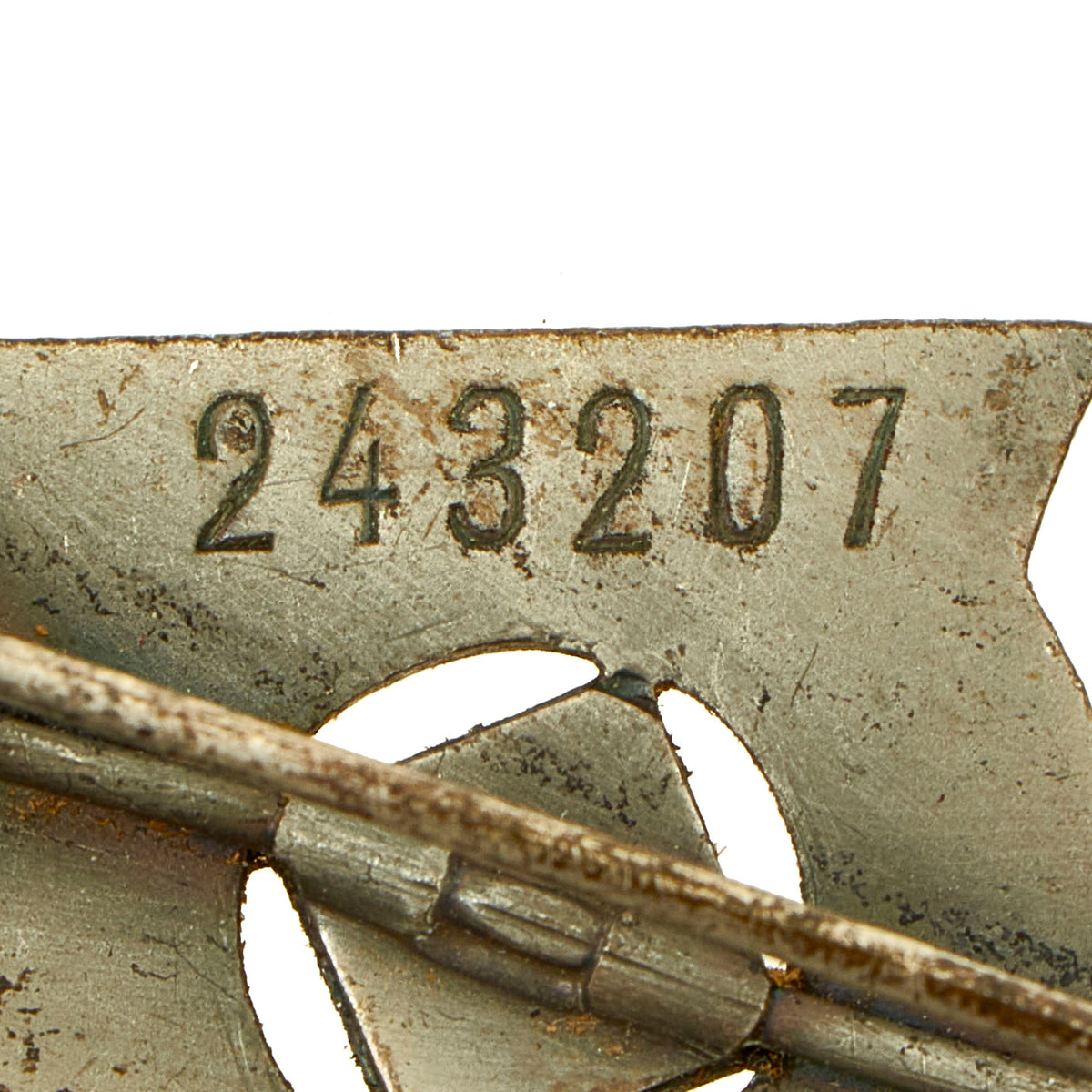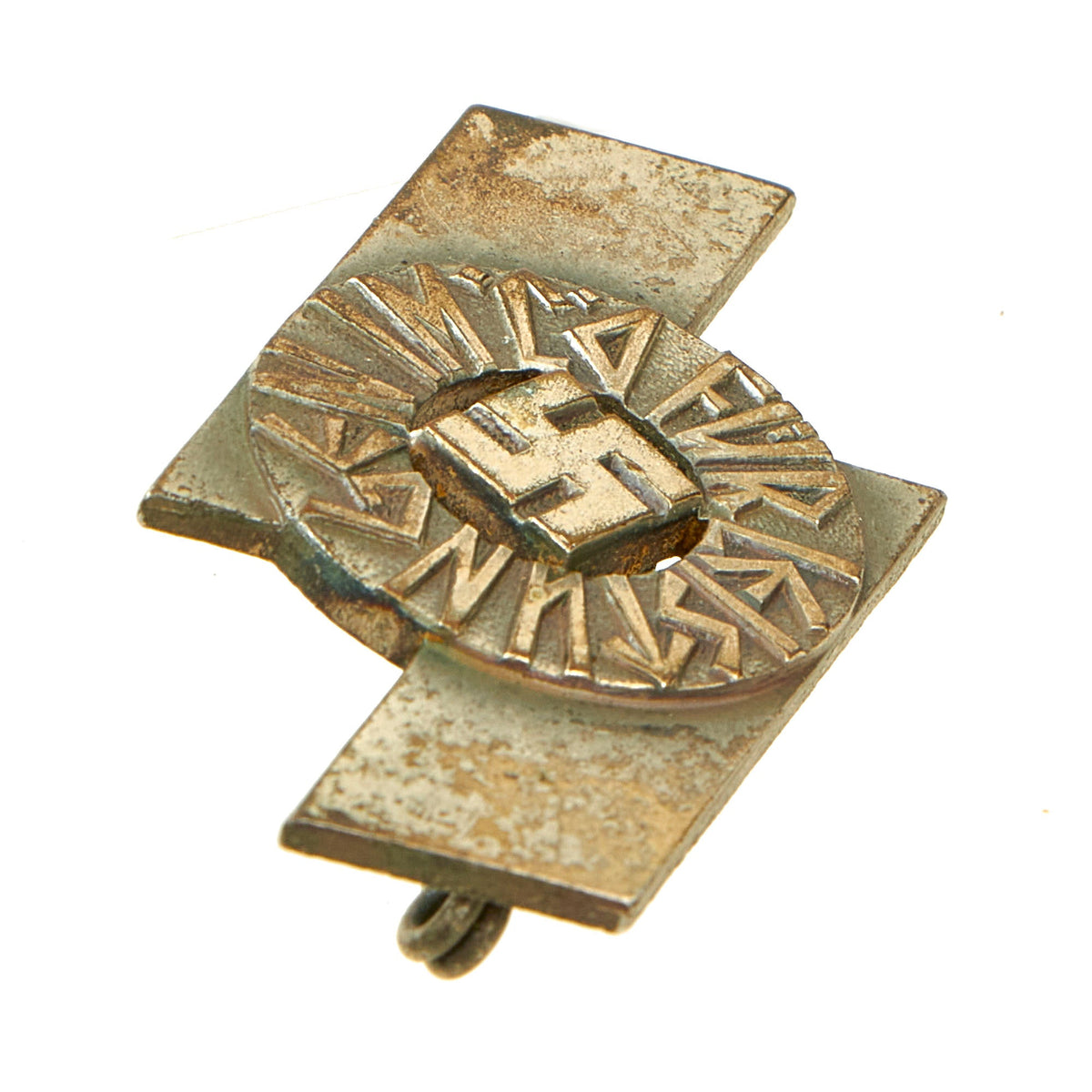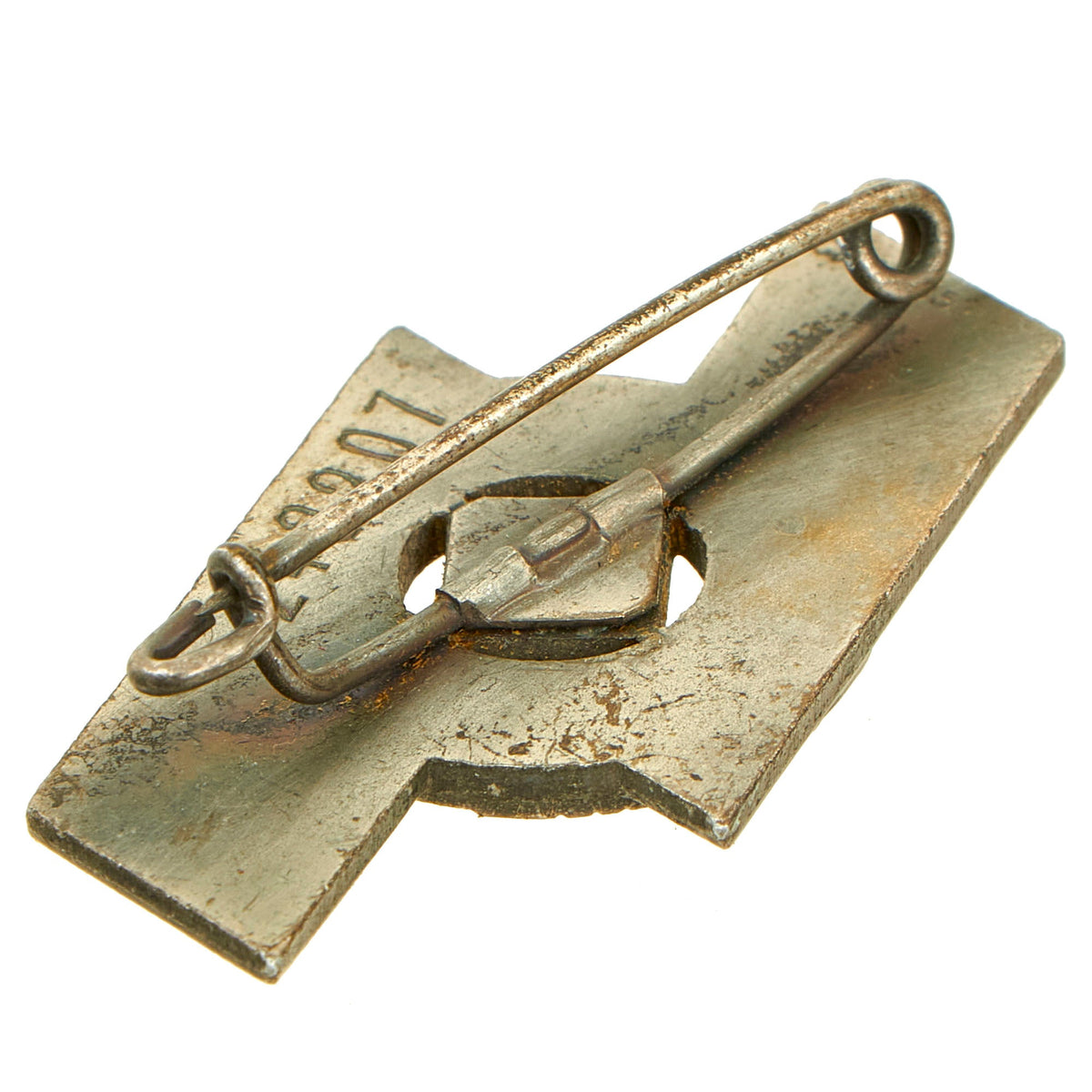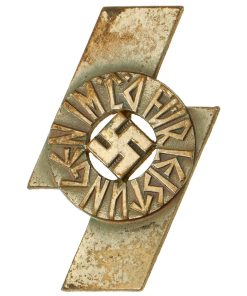Original German WWII DJ Deutsches Jungvolk Silver Proficiency Badge by Wachtler & Lange – RZM M1/35 Original Items
$ 195,00 $ 78,00
Original Item: Only One Available. This is a very nice hard to find German WWII Leistungsabzeichen des Deutschen Jungvolks (Proficiency Badge of the German Young People), one of the few that we have been able to offer over the years! The award was introduced by Reichsjugendführer Baldur von Schirach on September 26th 1935, and awarded to DJ members from the ages of twelve to fourteen years old after successful completion of the prescribed tests. The testing for award of the badge included military like training exercise and political indoctrination. The DJ Proficiency badge was issued in only one grade and bestowal was discontinued in 1944. As with most awards a cloth version was also authorized for wear by qualifying personnel.
The design of the badge features a single ᛋ Siegrune (Sig/Victory Rune) as a background. This design first became associated with the DJ on November 9th 1929, the sixth anniversary of the failed Beer Hall Putsch, when the Gauleiter of Vienna presented them with their first official flag, consisting of a black field with a central silver siegrune. In the center is a “mobile” NSDAP swas (hook cross), surrounded by runic style text reading FÜR LEISTUNGEN IM D.J. (for performance in the DJ). The badge measures just over 1 3/4 inches by 7/8 inch, and is completely non-magnetic.
The reverse of the badge features a large safety pin type attachment, which is fully functional. Just above this is a tiny (RZM) M1/35 maker code, for Wachtler & Lange of Mittweida, a known maker of this badge. There is also issue serial number 243207 stamped on the left side.
Overall condition is very good, with some wear and oxidation to the plating. A very nice example of a hard to find badge!
Of Note: In late 1934 items manufactured for the NSDAP and other organizations, including membership pins, came under the quality control of the RZM, Reichzeugmeisterei, (National Equipment Quartermaster) and as a result were marked with the RZM logo when appropriate. The registry was was based at the Brown house in Munich and NSDAP party headquarters in Berlin. The RZM ensured that the manufacturers of military items were consistent in design, quality of materials and other characteristics of the items. It also defined standards of design, manufacturing and quality and published an authoritative color chart for textiles. The M1 in the code stands for Metal Badges, with Wachtler & Lange of Mittweida being contractor number 35.
AH believed German youth to be the future of his 3rd Reich. The HJ AH Jugend or HJ) was formed officially in 1935, and with the exception of NSDAP ideology indoctrination was very similar to the Boy Scouts. Beginning at about the age of ten years, both boys (AH Jugend) and girls (Bund Deutscher Mädel) were enlisted in the Party-run organization. The The Deutsches Jungvolk (DJ) was the junior branch of the HJ, for boys aged 10 to 14.
History of the HJ National Youth Organization:
In 1922, the Munich-based NSDAP established its official youth organization called Jugendbund der NSDAP. It was announced on 8 March 1922 in the Völkischer Beobachter, and its inaugural meeting took place on 13 May the same year. Another youth group was established in 1922 as the Jungsturm Adolf “AH”. Based in Munich, Bavaria, it served to train and recruit future members of the Sturmabteilung (SA), the main paramilitary wing of the NSDAP Party at that time.
One reason the HJ so easily developed was that regimented organizations, often focused on politics, for young people and particularly adolescent boys were a familiar concept to German society in the Weimar Republic. Numerous youth movements existed across Germany prior to and especially after World War I. They were created for various purposes. Some were religious and others were ideological, but the more prominent ones were formed for political reasons, like the Young Conservatives and the Young Protestants. Once AH came onto the revolutionary scene, the transition from seemingly innocuous youth movements to political entities focused on AH was swift.
Following the abortive Beer Hall Putsch (in November 1923), NSDAP youth groups ostensibly disbanded, but many elements simply went underground, operating clandestinely in small units under assumed names. In April 1924, the Jugendbund der NSDAP was renamed Grossdeutsche Jugendbewegung (Greater German Youth Movement). On 4 July 1926, the Grossdeutsche Jugendbewegung was officially renamed HJ Bund der deutschen Arbeiterjugend (HJ League of German Worker Youth). This event took place a year after the NSDAP Party was reorganised. The architect of the re-organization was Kurt Gruber, a law student from Plauen in Saxony.
After a short power struggle with a rival organization—Gerhard Roßbach’s Schilljugend—Gruber prevailed and his “Greater German Youth Movement” became the NSDAP Party’s official youth organisation. In July 1926, it was renamed H -Jugend, Bund deutscher Arbeiterjugend (“H” Youth, League of German Worker Youth”) and, for the first time, it officially became an integral part of the SA. The name H -Jugend was taken up on the suggestion of Hans Severus Ziegler. By 1930, the Hjugend (HJ) had enlisted over 25,000 boys aged 14 and upward. They also set up a junior branch, the Deutsches Jungvolk (DJ), for boys aged 10 to 14. Girls from 10 to 18 were given their own parallel organization, the League of German Girls (BDM).
In April 1932, Chancellor Heinrich Brüning banned the H Youth movement in an attempt to stop widespread political violence. However, in June, Brüning’s successor as Chancellor, Franz von Papen, lifted the ban as a way of appeasing “AH”, the rapidly ascending political star. A further significant expansion drive started in 1933, after Baldur von Schirach was appointed by H as the first Reichsjugendführer (Reich Youth Leader). All youth organizations were brought under Schirach’s control.
Fast Shipping with Professional Packaging
Thanks to our longstanding association with UPS FedEx DHL, and other major international carriers, we are able to provide a range of shipping options. Our warehouse staff is expertly trained and will wrap your products according to our exact and precise specifications. Prior to shipping, your goods will be thoroughly examined and securely secured. We ship to thousands clients each day across multiple countries. This shows how we're dedicated to be the largest retailer on the internet. Warehouses and distribution centres can be located throughout Europe as well as the USA.
Note: Orders with more than one item will be assigned a processing date depending on the item.
Before shipping before shipping, we'll conduct a thorough inspection of the items you have ordered. Today, the majority of orders will be delivered within 48 hours. The delivery time will be between 3-7 days.
Returns
The stock is dynamic and we cannot completely manage it because multiple stakeholders are involved, including our factory and warehouse. So the actual stock may alter at any time. It's possible that you may not receive your order once the order has been made.
Our policy is valid for a period of 30 days. If you don't receive the product within 30 days, we are not able to issue a refund or an exchange.
You can only return an item if it is unused and in the same state as the day you received it. You must have the item in its original packaging.
Related products
Uncategorized
Uncategorized
Uncategorized
Uncategorized
Uncategorized
Uncategorized
Uncategorized
Uncategorized
Uncategorized
Armoured Fighting Vehicles of the World: AFVs of World War One (Hardcover Book) New Made Items
Uncategorized
Uncategorized
Uncategorized
Uncategorized
Uncategorized
Uncategorized
Uncategorized
Australian WWII Owen MK1 Machine Carbine SMG Custom Fabricated Replica with Sling Original Items
Uncategorized
